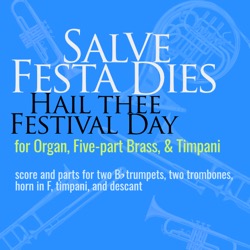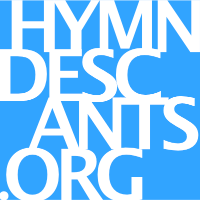Prologue -- Refrain -- B-verse -- Descant (refrain, with reprise) Free score.
Refrain
Hail thee, festival day!
Blest day to be hallowed forever;
Day when our Lord was raised,
Breaking the kingdom of death.
8 verse
Praise to the Giver of good!
Thou Love who art author of concord,
pour out thy balm on our souls,
order our ways in thy peace:
Refrain two times
Hail thee, festival day!
Blest day to be hallowed forever;
Day when our Lord was raised,
Breaking the kingdom of death. [repetas]
The hymn sung to SALVE FESTA DIES, was written by Venantius Fortunatus, a 6th C monk and eventually bishop of Poitiers. Due to the geographic latitude of the land in which he ministered, his poem Tempora florigero pairs the fair beauty of earth from the death of the winter arising with the Resurrection and victory over death. Hymnologist Ruth Ellis Messenger notes that he is the first on record in Christian hymnody to do this. In addition to the Easter text - drawn from the original - there are anonymous 12th C. variants for Ascension and Pentecost, each ending with the antiphon 'Hail thee, festival day' (L., Salve festa dies); there were also variants produced for feasts of the VIrgin, Corpus Christi, the Trinity, and All Saints (and for particular saints).
It was immediately used as a liturgical procession, to what music we may never know, and it considered a prototype of this use. Hymns up until this time were largely 'office hymns' sung in a monastic context. This was something different because it was used in public liturgical celebrations, and its authorship was certain. Its prestige as the prototype of  A version for brass quintet and timp is available (audition on the linked page)processional hymns was cemented at St. Gall in the 10th C., with subsequent evolutionary practices were encoded in the Sarum and York rites. The original Latin was an extensive 110-line poem opening with life from the death of the winter arising theme, the verse Salve feste dies toto venerabilis aevo ("Hail fesitival day, fully venerated through all ages") appearing at line 39.
A version for brass quintet and timp is available (audition on the linked page)processional hymns was cemented at St. Gall in the 10th C., with subsequent evolutionary practices were encoded in the Sarum and York rites. The original Latin was an extensive 110-line poem opening with life from the death of the winter arising theme, the verse Salve feste dies toto venerabilis aevo ("Hail fesitival day, fully venerated through all ages") appearing at line 39.
The tune SALVE FESTA DIES is one of the four Ralph Vaughan Williams original hymn tunes in The English Hymnal, and is characterized by an energetic rhythm with a pronounced forward motion. Because the setting includes two verses sung alternatim with the antiphon, even the longest of the settings - Easter - sustains congregational interest throughout. The variants for Ascension, and Pentecost are shorter.
Of particular interest is the introduction of 'God, the All-father,' into some hymnals, connecting the trinitarian First Person to the ancient Norse deity Odin, Alföðr. (In Anglo-Saxon, this is Woden, for whom Wednesday is named.) This is not in the original Latin, but was introduced by Pearcy Dearmer in Songs of Praise (1931). The change was short lived: most English language hymnals over time have reverted to the original, which is especially helpful to those (most) of us who might lack the necessary historical or cultural context to appreciate this detail about a pre-Christian mythological god who sacrificed himself to himself.
More reading
History of Hymns: "Hail Thee, Festival Day" - C. Michael Hawn, UMC Discipleship Ministries
XVII.–Salve festa dies – Ruth Ellis Messenger, Transactions and Proceedings of the American Philological Association, Vol. 78 (1947), pp. 208-222 via JSTOR (login required, but online version is free)
Updated: April 2019
Combined document with prologue intro), organ score, and choir part
Descant verse (Easter):
Hail thee festival day!
Blest day that are thallowed forever;
Day whereon Christ arose
breaking the kingdom of death
– Venantius Fortunatus, 6th C.

